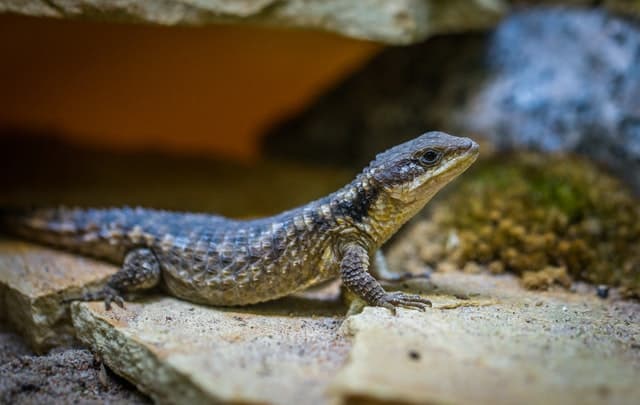
When we see a gecko in the house, most of us usually don’t react very well. On the contrary, we are inclined to chase the animal out of the home as quickly as possible, believing it to be dangerous. Yet this cute little animal has always been considered a symbol of regeneration, adaptability, strength and vitality , which is why it is found in many artistic representations and tattoos.
Furthermore, the gecko is anything but dangerous. The popular belief , therefore, identifies the gecko’s a real luck that some people breed in the house like any pet . Indeed, being a small lizard , it hunts for insects and spiders that are much more annoying and fearful for human health.
But what are the peculiarities that make this little reptile so special? Let’s find out together in this guide dedicated to him.
Appearance and general characteristics
The gecko ( Common gecko or Tarentola mauritanica Linnaeus ), is a small reptile belonging to the suborder of saurians . Its family is that of the Gekkonidae , which in turn includes several subcategories very widespread throughout the Mediterranean area , especially along the coastal strips.
The common gecko is the most widespread in Europe and is a close relative of the lizard . Just like the latter, it is absolutely harmless to humans and feeding on insects such as flies, mosquitoes , moths and cockroaches is definitely useful for humans and the ecosystem.
The habitat of the gecko consists of stony ground, quarries, dry stone walls, piles of wood, but above all the buildings and homes where they love to stay without fearing the presence of humans or other animals, including cats .
Normally, the gecko has a small to medium size that does not exceed 16 centimeters in length including the tail. The head is larger than the body, the muzzle is pointed and the eyes are large and round. It has a sturdy, decidedly plump and slightly flattened body that allows it to slip anywhere, even in the narrowest holes.
The back and the tail are gray or brown, but the colors change according to the environmental conditions and the light allowing it to exploit a good camouflage ability .
The whole body of the gecko is covered with tubercles which give it a ‘rough’ not to say ‘thorny’ appearance, a characteristic that in many people arouses a sense of repulsion and fear. The largest specimens are the males , while the small geckos have more evident dark streaks which then lose during growth.
The gecko’s most obvious skill is its quickness of movement and the ability to quickly climb anywhere. It is a territorial animal , stubborn and tenacious that defends its territory in a fearless and impetuous way.
Few animals, in fact, dare to challenge a gecko to conquer a prey or a space, and this is one of the most amazing requirements of this miniature dragon .
Gecko in the house: what to do?
We have already said that the gecko is absolutely not a dangerous animal, on the contrary, it eats a large amount of insects and spiders. However, finding one at home can be a problem for many people.
The first rule to observe in this case is to act with a little common sense : it is not necessary to drive away the animal violently or harm it. There are completely natural tricks and remedies that can cause the gecko to spontaneously leave our home and prevent it from happening again.
The first trick is to sprinkle some mothballs here and there . The gecko hates this smell and for sure it will not stay long in the house if it will even smell it. By inserting it into the dampest drawers or openings we will certainly not see geckos walking along the walls of our living room …
The other thing the gecko just doesn’t tolerate is water . Try to spray a little cold water on the animal and you will see that it will go away in a hurry realizing that it is not the welcome.
Just like the lizards, the gecko is also able to self-amputate its tail, which allows it to easily get rid of the terminal part of its body that could end up in the clutches of predators or other animals. Keep in mind in case you plan to catch the gecko by the tail!
In the event that the gecko has already peeped into the house and does not decide to abandon it for any reason in the world, we can gently use a nice fishing net and try to catch it. Certainly not a simple task given the speed with which it moves and its ability to slip into all the cracks, but with a little patience …
How long does the gecko live and what does it eat?
A gecko reaches sexual maturity between 4 and 5 years of age and its life generally extends up to about 10 years . The females of some species of these reptiles reproduce by parthenogenesis , ie without the help of the male.
As mentioned, the gecko feeds mainly on mosquitoes, flies, moths, spiders, cockroaches and midges . Occasionally, it also hunts for ants , winged or not, and small invertebrates. Not infrequently, they also feed on fruit and nectar. In winter, geckos take refuge in underground burrows and in the ribs of trees to protect themselves from the cold and sleep, without however entering into a real hibernation.
Which are the different Gecko Breeds?
- Fat-Tailed Geckos
- Gargoyle Geckos
- Frog Eyed Geckos
- Giant Day Geckos
- Tokay Geckos
- Leopard Geckos
- Crested Geckos
Interesting Fact:
Scientists and researchers around the world have studied the gecko’s truly extraordinary ability to adhere to any surface . The merit is of the special paws with which this animal is equipped. The fingers, in particular, are small engineering masterpieces of nature: they have tiny bearings and a series of longitudinal lamellae that allow the reptile not to slip and climb with extreme ease.
In practice it is as if it had hundreds of bristles that adhere perfectly even on the most slippery surfaces. To detach them, the animal does not have to struggle, but simply change their inclination. The only material that the gecko’s legs cannot adhere to is Teflon .
Researchers from the Polytechnic of Turin are developing a special suit inspired by the legs of the gecko. Gloves and shoes of this suit would be coated with a particular carbon nanotube- based glue that makes them super-adhesive on any surface.
In practice, a technology that behaves like velcro , exactly what allows geckos to move quickly in any situation. Incredible, but true …






